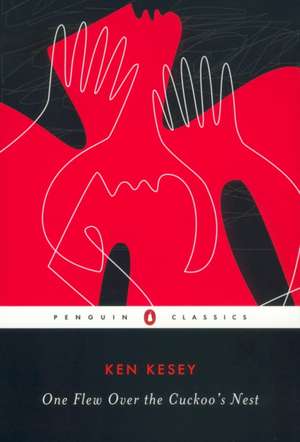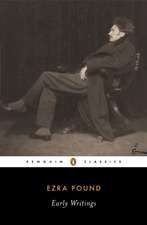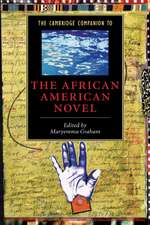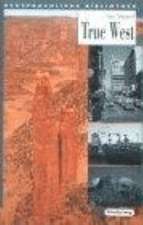One Flew Over the Cuckoo's Nest: Penguin Classics
Autor Ken Kesey Ed McClanahan, Robert Faggenen Limba Engleză Paperback – 30 noi 2002 – vârsta de la 18 ani
Boisterous, ribald, and ultimately shattering, Ken Kesey’s One Flew Over the Cuckoo’s Nest is the seminal novel of the 1960s that has left an indelible mark on the literature of our time. Here is the unforgettable story of a mental ward and its inhabitants, especially the tyrannical Big Nurse Ratched and Randle Patrick McMurphy, the brawling, fun-loving new inmate who resolves to oppose her. We see the struggle through the eyes of Chief Bromden, the seemingly mute half-Indian patient who witnesses and understands McMurphy’s heroic attempt to do battle with the awesome powers that keep them all imprisoned. This edition includes a new foreword by Kesey, a new text introduction by Robert Faggen, and line drawings the author made when writing the book, many never before published.
| Toate formatele și edițiile | Preț | Express |
|---|---|---|
| Paperback (6) | 53.66 lei 21-33 zile | +19.89 lei 6-12 zile |
| Penguin Books – 4 mai 2005 | 53.66 lei 21-33 zile | +19.89 lei 6-12 zile |
| Signet Book – 31 ian 1963 | 60.35 lei 3-5 săpt. | +10.17 lei 6-12 zile |
| Penguin Books – 25 iun 2008 | 70.26 lei 21-33 zile | +26.72 lei 6-12 zile |
| Penguin Books – 30 noi 2002 | 95.29 lei 3-5 săpt. | |
| Penguin Books – 18 oct 2016 | 97.74 lei 3-5 săpt. | +16.45 lei 6-12 zile |
| Penguin Books – 31 dec 1995 | 190.40 lei 3-5 săpt. | |
| Hardback (1) | 175.99 lei 3-5 săpt. | |
| Viking Books – 31 dec 2011 | 175.99 lei 3-5 săpt. |
Din seria Penguin Classics
-
 Preț: 81.00 lei
Preț: 81.00 lei -
 Preț: 103.12 lei
Preț: 103.12 lei -
 Preț: 94.66 lei
Preț: 94.66 lei -
 Preț: 100.22 lei
Preț: 100.22 lei -
 Preț: 129.73 lei
Preț: 129.73 lei -
 Preț: 103.53 lei
Preț: 103.53 lei -
 Preț: 80.44 lei
Preț: 80.44 lei -
 Preț: 76.28 lei
Preț: 76.28 lei -
 Preț: 98.97 lei
Preț: 98.97 lei -
 Preț: 67.61 lei
Preț: 67.61 lei -
 Preț: 119.60 lei
Preț: 119.60 lei -
 Preț: 95.29 lei
Preț: 95.29 lei -
 Preț: 64.54 lei
Preț: 64.54 lei -
 Preț: 74.21 lei
Preț: 74.21 lei -
 Preț: 119.20 lei
Preț: 119.20 lei -
 Preț: 101.17 lei
Preț: 101.17 lei -
 Preț: 133.62 lei
Preț: 133.62 lei -
 Preț: 77.15 lei
Preț: 77.15 lei -
 Preț: 110.75 lei
Preț: 110.75 lei -
 Preț: 87.86 lei
Preț: 87.86 lei -
 Preț: 81.03 lei
Preț: 81.03 lei -
 Preț: 78.77 lei
Preț: 78.77 lei -
 Preț: 135.25 lei
Preț: 135.25 lei -
 Preț: 92.40 lei
Preț: 92.40 lei -
 Preț: 95.29 lei
Preț: 95.29 lei -
 Preț: 88.86 lei
Preț: 88.86 lei -
 Preț: 102.21 lei
Preț: 102.21 lei -
 Preț: 110.15 lei
Preț: 110.15 lei -
 Preț: 119.53 lei
Preț: 119.53 lei -
 Preț: 93.84 lei
Preț: 93.84 lei -
 Preț: 64.54 lei
Preț: 64.54 lei -
 Preț: 89.29 lei
Preț: 89.29 lei -
 Preț: 107.67 lei
Preț: 107.67 lei -
 Preț: 75.87 lei
Preț: 75.87 lei -
 Preț: 96.30 lei
Preț: 96.30 lei -
 Preț: 90.11 lei
Preț: 90.11 lei -
 Preț: 113.78 lei
Preț: 113.78 lei -
 Preț: 100.42 lei
Preț: 100.42 lei -
 Preț: 75.15 lei
Preț: 75.15 lei -
 Preț: 132.76 lei
Preț: 132.76 lei -
 Preț: 87.86 lei
Preț: 87.86 lei -
 Preț: 93.43 lei
Preț: 93.43 lei -
 Preț: 135.89 lei
Preț: 135.89 lei -
 Preț: 100.01 lei
Preț: 100.01 lei -
 Preț: 105.58 lei
Preț: 105.58 lei -
 Preț: 112.74 lei
Preț: 112.74 lei -
 Preț: 96.30 lei
Preț: 96.30 lei -
 Preț: 90.73 lei
Preț: 90.73 lei -
 Preț: 88.04 lei
Preț: 88.04 lei
Preț: 95.29 lei
Nou
Puncte Express: 143
Preț estimativ în valută:
18.23€ • 19.04$ • 15.09£
18.23€ • 19.04$ • 15.09£
Carte disponibilă
Livrare economică 14-28 martie
Preluare comenzi: 021 569.72.76
Specificații
ISBN-13: 9780141181226
ISBN-10: 0141181222
Pagini: 320
Dimensiuni: 130 x 199 x 14 mm
Greutate: 0.22 kg
Editura: Penguin Books
Seria Penguin Classics
ISBN-10: 0141181222
Pagini: 320
Dimensiuni: 130 x 199 x 14 mm
Greutate: 0.22 kg
Editura: Penguin Books
Seria Penguin Classics
Cuprins
Sketches by Ken Kesey vii
Introduction by Robert Faggen ix
Part One 1
Part Two 127
Part Three 173
Part Four 223
Introduction by Robert Faggen ix
Part One 1
Part Two 127
Part Three 173
Part Four 223
Recenzii
"A glittering parable of good and evil." —The New York Times Book Review
"A roar of protest against middlebrow society’s Rules and the Rulers who enforce them." —Time
"A roar of protest against middlebrow society’s Rules and the Rulers who enforce them." —Time
Notă biografică
Ken Kesey was born in 1935 and grew up in Oregon. He graduated from the University of Oregon and later studied at Stanford with Wallace Stegner, Malcolm Cowley, Richard Scowcroft, and Frank O' Connor. One Flew Over the Cuckoo's Nest, his first novel, was published in 1962. His second novel, Sometimes a Great Notion, followed in 1964. His other books include Kesey's Garage Sale, Demon Box, Caverns (with O. U. Levon), The Further Inquiry, Sailor Song, and Last Go Round (with Ken Babbs). His two children's books are Little Tricker the Squirrel Meets Big Double the Bear and The Sea Lion. Ken Kesey died on November 10, 2001.
Robert Faggen teaches at Claremont McKenna College.
Robert Faggen teaches at Claremont McKenna College.
Extras
Sketches
Psychedelic sixties. God knows whatever that means it certainly meant far more than drugs, though drugs still work as a pretty good handle to the phenomena.
I grabbed at that handle. Legally, too, I might add. Almost patriotically, in fact. Early psychedelic sixties...
Eight o'clock every Tuesday morning I showed up at the vet's hospital in Menlo Park, ready to roll. The doctor deposited me in a little room on his ward, dealt me a couple of pills or a shot or a little glass of bitter juice, then locked the door. He checked back every forty minutes to see if I was still alive, took some tests, asked some questions, left again. The rest of the time I spent studying the inside of my forehead, or looking out the little window in the door. It was six inches wide and eight inches high, and it had heavy chicken wire inside the glass.
You get your visions through whatever gate you're granted.
Patients straggled by in the hall outside, their faces all ghastly confessions. Sometimes I looked at them and sometimes they looked at me. but rarely did we look at one another. It was too naked and painful. More was revealed in a human face than a human being can bear, face-to-face.
Sometimes the nurse came by and checked on me. Her face was different. It was painful business, but not naked. This was not a person you could allow yourself to be naked in front of.
Six months or so later I had finished the drug experiments and applied for a job. I was taken on as a nurse's aide, in the same ward, with the same doctor, under the same nurse—and you must understand we're talking about a huge hospital here! It was weird.
But, as I said, it was the sixties.
Those faces were still there, still painfully naked. To ward them off my case I very prudently took to carrying around a little notebook, to scribble notes. I got a lot of compliments from nurses: "Good for you, Mr. Kesey. That's the spirit. Get to know these men."
I also scribbled faces. No, that's not correct. As I prowl through this stack of sketches I can see that these faces bored their way behind my forehead and scribbled themselves. I just held the pen and waited for the magic to happen.
This was, after all, the sixties.
Ken Kesey
Psychedelic sixties. God knows whatever that means it certainly meant far more than drugs, though drugs still work as a pretty good handle to the phenomena.
I grabbed at that handle. Legally, too, I might add. Almost patriotically, in fact. Early psychedelic sixties...
Eight o'clock every Tuesday morning I showed up at the vet's hospital in Menlo Park, ready to roll. The doctor deposited me in a little room on his ward, dealt me a couple of pills or a shot or a little glass of bitter juice, then locked the door. He checked back every forty minutes to see if I was still alive, took some tests, asked some questions, left again. The rest of the time I spent studying the inside of my forehead, or looking out the little window in the door. It was six inches wide and eight inches high, and it had heavy chicken wire inside the glass.
You get your visions through whatever gate you're granted.
Patients straggled by in the hall outside, their faces all ghastly confessions. Sometimes I looked at them and sometimes they looked at me. but rarely did we look at one another. It was too naked and painful. More was revealed in a human face than a human being can bear, face-to-face.
Sometimes the nurse came by and checked on me. Her face was different. It was painful business, but not naked. This was not a person you could allow yourself to be naked in front of.
Six months or so later I had finished the drug experiments and applied for a job. I was taken on as a nurse's aide, in the same ward, with the same doctor, under the same nurse—and you must understand we're talking about a huge hospital here! It was weird.
But, as I said, it was the sixties.
Those faces were still there, still painfully naked. To ward them off my case I very prudently took to carrying around a little notebook, to scribble notes. I got a lot of compliments from nurses: "Good for you, Mr. Kesey. That's the spirit. Get to know these men."
I also scribbled faces. No, that's not correct. As I prowl through this stack of sketches I can see that these faces bored their way behind my forehead and scribbled themselves. I just held the pen and waited for the magic to happen.
This was, after all, the sixties.
Ken Kesey
Descriere
Boisterous, ribald, and ultimately shattering, Kesey's work is the seminal novel of the 1960s that has left an indelible mark on literature. Here is the unforgettable story of a mental ward and its inhabitants, especially the tyrannical Big Nurse Ratched and Randle Patrick McMurphy, the brawling, fun-loving new inmate who resolves to oppose her.



















